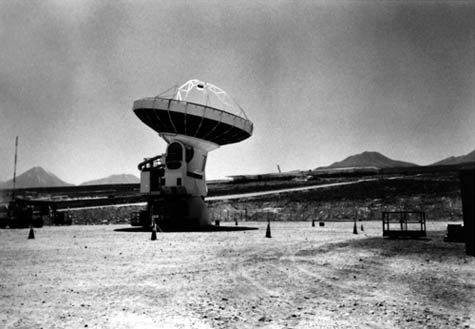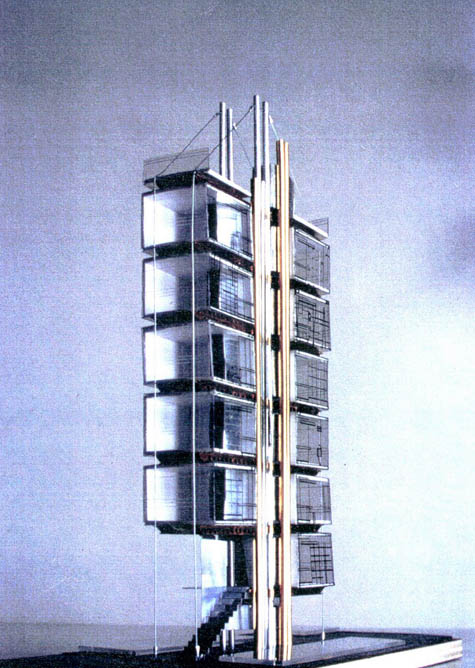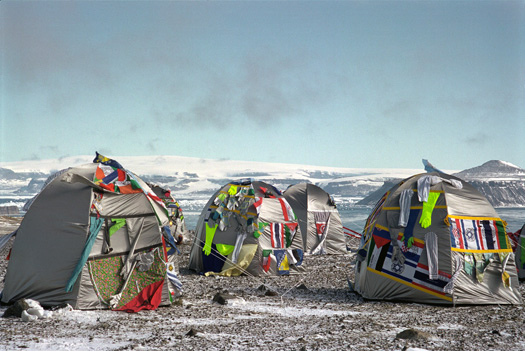Extreme Environments
Opening today in Paris is a new exhibition called Uninhabitable? Art of Extreme Environments. Featured artists include Catherine Rannou, Connie Mendoza, and Studio Orta, among many others.
 [Image: From Numerical Desert by Connie Mendoza].
[Image: From Numerical Desert by Connie Mendoza].
Rannou's work has ranged from speculative building projects for spatially challenging sites in the city (seen below) to her work Colonisation 2041, featured in the exhibition. This latter project is "an installation reflecting the active and actual occupation that the development of scientific stations in Antarctica represents; energy dependence, waste management, roads and tunnels, planes, tractors, helicopters, and building materials all point to a form of 'urbanisation' that is clearly in progress."
 [Image: Parentheses, an "habiter dans les interstices de la ville," by Catherine Rannou].
[Image: Parentheses, an "habiter dans les interstices de la ville," by Catherine Rannou].
Meanwhile, Connie Mendoza produces diagrammatic artworks, analyses of the optical landscapes of mirages, and fascinating quasi-documentary photo-projects, including the stunning Moon Landscapes and Numerical Desert. Numerical Desert, which will be on display in Paris, explores the Atacama Large Millimeter Array through black-and-white photos; it comes with "drawings based on the data of the astronomical observation of stars and galaxies in coverage of the whole southern celestial hemisphere." She's also got a blog.
 [Image: Antarctic Village by Studio Orta].
[Image: Antarctic Village by Studio Orta].
Studio Orta's work touches on political questions associated with empty landscapes – including the question of whether or not one could ever be a citizen of Antarctica. Their Antarctic Village, for instance, pictured above, falls somewhere between an experiment in extreme camping and a stab at temporary utopian space unaffiliated with national governments.
(Thanks to William Fox for the tip!)
 [Image: From Numerical Desert by Connie Mendoza].
[Image: From Numerical Desert by Connie Mendoza].Rannou's work has ranged from speculative building projects for spatially challenging sites in the city (seen below) to her work Colonisation 2041, featured in the exhibition. This latter project is "an installation reflecting the active and actual occupation that the development of scientific stations in Antarctica represents; energy dependence, waste management, roads and tunnels, planes, tractors, helicopters, and building materials all point to a form of 'urbanisation' that is clearly in progress."
 [Image: Parentheses, an "habiter dans les interstices de la ville," by Catherine Rannou].
[Image: Parentheses, an "habiter dans les interstices de la ville," by Catherine Rannou].Meanwhile, Connie Mendoza produces diagrammatic artworks, analyses of the optical landscapes of mirages, and fascinating quasi-documentary photo-projects, including the stunning Moon Landscapes and Numerical Desert. Numerical Desert, which will be on display in Paris, explores the Atacama Large Millimeter Array through black-and-white photos; it comes with "drawings based on the data of the astronomical observation of stars and galaxies in coverage of the whole southern celestial hemisphere." She's also got a blog.
 [Image: Antarctic Village by Studio Orta].
[Image: Antarctic Village by Studio Orta].Studio Orta's work touches on political questions associated with empty landscapes – including the question of whether or not one could ever be a citizen of Antarctica. Their Antarctic Village, for instance, pictured above, falls somewhere between an experiment in extreme camping and a stab at temporary utopian space unaffiliated with national governments.
- Antarctic Village is emblematic of Ortas’ body of work, composed of what could be termed modular architecture and reflecting qualities of nomadic shelters and campsites. The dwellings themselves are hand stitched together by a traditional tent maker with sections of flags from countries around the world, along with extensions of clothes and gloves, symbolising the multiplicity and diversity of people.
(Thanks to William Fox for the tip!)





Comments are moderated.
If it's not spam, it will appear here shortly!
These buildings are very interesting in structure or just the basic thoughts put into them. The middle picture is more capturing and would be very interesting to see in real life. Im not sure how to describe my interest other than that it reminds me almost of a hamster cage trail.
There have been a couple of awkward attempts by Argentina and Chile over the years to create a "citizenship" of Antartica. In 1978 a pregnant woman and her husband traveled to Antartica, upon strong urging from the government, and became the first to give birth on the continent. Later Chile retaliated by conducting the first marriage on the continent. Both incidents must have necessitated strange physical modifications to the existing spaces or new architectures entirely.
"Studio Orta's work touches on political questions associated with empty landscapes – including the question of whether or not one could ever be a citizen of Antarctica."
Let's not overlook the fact that at some time in the past, Antarctica was a tropical paradise, and will become that way again. Whether humans live long enough to see that day is open to speculation, but eventually continental drift will move it away from the pole. Assuming the constantly shifting climate of our planet doesn't swing back to hot and swampy and just melt it where it lies.
Post a Comment